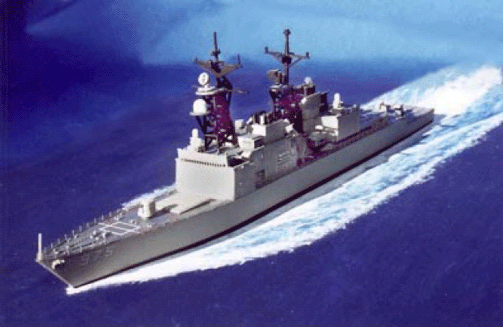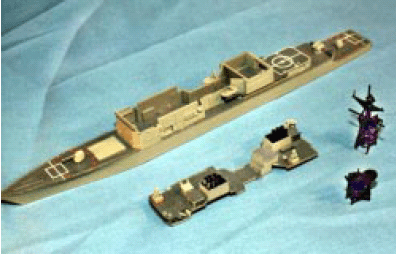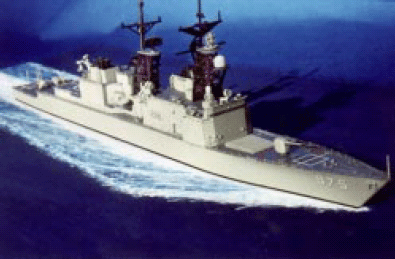
          
|
Fujimi’s 1/700 Spruance Class Destroyer - USS O’BrienBy Richard Eaton, Originally published February 2005
Introduction I reviewed the Fujimi Spruance Class destroyer (USS O’Brien) in 1/700 scale in the May issue of Internet Modeler. Armed with a bit of Eduard PE railings, I recently launched into this one. This is the first time I have worked with 1/700 PE. After so many years of modeling, it is interesting to encounter a “first.” It was challenging. Read on. The Class Spruance Class destroyers were designed as replacements for the aging Allen M. Sumner (DD-692) and Gearing (DD-710) class ships whose service lives ended in the mid-1970s. All 31 ships in the class were built by Ingalls Shipbuilding Division of Litton Industries at Pascagoula, MS. Designed for the future installation of weapons systems and sensors not yet developed, and with an unprecedented attention to habitability, the result was a destroyer larger than many WWII-era cruisers. They were the first U.S. Navy major combatants to employ gas turbine engines as their main propulsion. Highly specialized ASW ships, their primary AA defense is a point-defense missile system. The target of much criticism, many viewed the advent of the Spruance destroyer as a reversal of roles from the traditional destroyer, from hunter to hunted. Throughout the years, these ships have received a number of modifications and upgrades. Now, more than 22 years since the lead ship of this class entered service, Spruance Class destroyers have taken their rightful place as the workhorse of the U.S. fleet. Like the traditional (hunter) destroyers of WWII, their service as all-purpose fighting ships is marked with exceptional performance in a variety of missions. Building O’Brien This 1999 kit, from Fujimi, places all the latest technology on the O’Brien. It is a dandy, with clean crisp moldings and no flash. The parts consist of five trees of hard gray styrene parts, a metal “ballast” bar, and two decal sheets. As is my habit, I separated and sprayed the parts while on the sprue. I painted the ships decks with Testors Gunship Gray, the hull and superstructure Light Aircraft Gray, and masts and exhausts Flat Black. Careful paint application at the start of a kit like this saves a ton of masking down the road. Following directions, step one assembled the ship’s guns, turbine cooling, and exhaust housings. Two parts make up each of the cooling housings. A separate decal sheet has vent details to apply to all four sides of each structure. Each exhaust structure is made up of nine parts including separate tiny stacks. Fit was perfect and only minor sanding and touch-up completed the assemblies.
In step two I mounted the stacks and other components on the superstructure deck. I also assembled the superstructure and flight deck out of individual bulkheads and decking. Careful alignment left little to clean up. I posed the hanger doors open because I wanted to show the helicopter as it was emerging from the shelter. Next, I secured the superstructure, and other major assemblies onto the hull piece. I kept the top deck separate to ease decalling and adding PE rails. With the hull basically complete, I applied a coat of clear gloss over the entire ship. Decals for the kit include extensive deck warning striping, flight deck, and bridge windows. These were large sheet decals with plenty of clear area so I was afraid of silvering. I applied Future acrylic floor polish over all decal areas. I then applied the decals. So far, so good. I then applied more Future over the decals and, when dry, they looked painted on. The bridge window decals were a particularly nice touch.
The ship was now ready for the PE railings. Actually the ship was more ready than I was. I had sprayed the PE with the ship's colors. The Eduard PE is finely done and extremely delicate. I started with the top deck. It has been a while since some aspect of modeling has kicked my behind. This was it. After a full night of experimenting I finally got the right combination of magnification so that I could see what I was doing. After a few tries, I could actually cut the railings from the fret successfully. I could not bend the rails to fit (as I would in 1/350 scale PE) on the first few attempts. Suffering my whimpering, I was given some much needed encouragement and advice. I saw improvement in the next few sessions and got the railings done. Not pretty but done. Whew! I then assembled the ships masts, SH-60B helicopter and remaining items. The final step in the directions added all the remaining items onto the hull. Boy, I wish that I had added all these prior to the PE. PE 1/700 railing are delicate and, despite my care, received some damage. I used CA to add the mast structures, antennae, Harpoon launchers, and helicopter. Then the ship went under the magnifier again to straighten out all that bent PE. At this stage I noticed that the flight deck looked pretty bare without any safety webbing. All I had was railing. Well, what the heck. I constructed webbing out of the railings as best I could and applied them. Hey, a few days ago I couldn't even cut this stuff off the fret! What do you know? A little dry brushing and touch-up and she was done. I painted a water scene using acrylic Navy Blue, White, and a touch of Turquoise. I tacked the ship on with a touch of glue and took it out in the sun for some photos. Conclusion
I thank HobbyLink Japan http://www.hlj.com for this review sample. References
|
© Copyright 2010, Austin Scale Modelers Society (ASMS)



 This kit builds up to a really nice looking model. The numerous
detailed parts fit well and, with careful painting, make a convincing
Spruance class destroyer. I think average modelers
would have a great time building up this nice kit right out of the
box. More advanced modelers should add PE railings to add that
level of realism. I think my next crack at 1/700 PE should go a
lot smoother having this one under my belt.
This kit builds up to a really nice looking model. The numerous
detailed parts fit well and, with careful painting, make a convincing
Spruance class destroyer. I think average modelers
would have a great time building up this nice kit right out of the
box. More advanced modelers should add PE railings to add that
level of realism. I think my next crack at 1/700 PE should go a
lot smoother having this one under my belt.